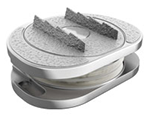ProDisc is a Total Disc Replacement (TDR) technology platform, specifically designed for cervical (ProDisc-C) and lumbar (ProDisc-L) spine surgeries, aiming to restore disc height, motion, and function, while reducing pain and potentially decelerating adjacent level degeneration.
Here’s a more detailed explanation:
ProDisc C (Cervical):
- Purpose:Used to reconstruct a diseased intervertebral disc in the cervical spine (C3-C7) following discectomy for intractable symptomatic cervical disc disease (SCDD).
- Mechanism:Restores normal disc height, decompresses surrounding neural structures, and potentially provides motion in the affected vertebral segment.
- Design:A ball and socket implant with two cobalt chrome alloy end plates.
- Benefits:Reduces pain, restores normal dynamic function of the spine, and potentially decelerates adjacent level degeneration.
- Indications:Skeletally mature patients with SCDD, including neck or arm pain and/or functional/neurological deficits, confirmed by imaging (CT, MRI, or X-rays).
- ProDisc C Vivo:A variant of the ProDisc-C with a domed superior endplate and keel-less design for streamlined implantation.
- ProDisc C SK:A variant of the ProDisc-C with a smaller keel and simplified keel preparation technique.
- ProDisc C Nova:A variant of the ProDisc-C with unique tri-keels designed to improve fixation in certain endplate morphologies.
ProDisc L (Lumbar):
- Purpose:Used to replace a lumbar intervertebral disc and restore disc height and segmental motion.
- Design:A ball and socket design with a semi-constrained fixed core, providing a fixed center of rotation and a physiologic range of motion.
- Benefits:Reduces pain, preserves motion, and improves patient function in patients with degenerative disc disease at one or two levels between L3 and S1.
- Fixation:Endplates have patented central keels and lateral spikes for initial fixation to the vertebral bodies, and a plasma sprayed titanium coating on all bone contacting surfaces to promote bony integration.
- Motion:The kinematics correspond to the physiological conditions in the vertebral joints, with a rotational center just below the superior endplate of the affected caudal vertebral body.
- Angulation:There are angulation options for both superior and inferior endplates
